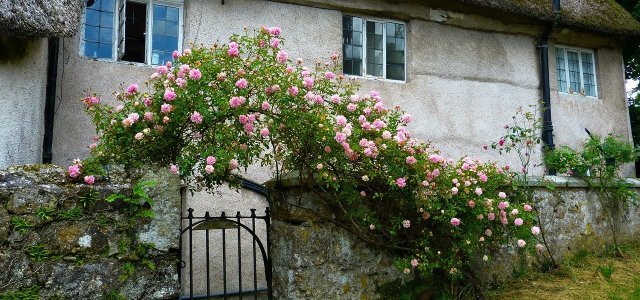
Climbing roses need to be pruned differently than rose bushes. What you should pay attention to and how best to proceed, you can read in our guide.
Contents
Pruning climbing roses: Single-flowering or repeat-flowering?
Before you can even begin to prune your climbing roses, you need to know whether your climbing roses are once- or twice-yearly blooming specimens.
By the way, once-blooming climbing roses are also called ramblers. More frequent bloomers, on the other hand, are called climbers.
If you’re not quite sure, below are some characteristics of the two types:
- Rambler (once-blooming) blooms from May to July. Most of the flowers are on the side shoots that grew the previous year. The tendrils grow quickly and are flexible. Rambler grow between three and ten meters high.
- Climbers (more frequent bloomers) also bloom for the first time from May to July and then again from August to October or November. The flowers are on the tendrils that have grown this year and last year. The flowers are quite a bit larger than those of ramblers. The shoots are stiffer. Climbers grow less quickly and only reach about two to four feet tall.
- Below you will find two separate instructions – once for the single-flowering climbing roses and once for the more frequent flowering.
Cut single-flowered climbing roses: How to do it
Single-flowering climbing roses are pruned only once a year. Rambler grow fast and wild – but you can let them grow for the first five years if you have enough space. From the fifth year on, you should then prune them annually.
There are different opinions about the optimal time: Some recommend the time right after flowering (summer), others recommend spring for pruning. If you are unsure about this, you can get advice from a specialist store.
The general rule here is: Cut once-blooming climbing roses as little as possible. Since most of the blooms appear on older shoots, you should leave them alone for the most part.
- Remove dead and very old, weak shoots. Old shoots can be recognized by the fact that they only have a few flowers left.
- Cut away withered parts of the plant.
- If shoots interfere with each other, grow crosswise or look sick, remove them too. Note: If you remove diseased shoots, you should clean your tools afterwards so that you do not transfer possible germs to healthy shoots.
- Do not cut off very long shoots, but tie them as horizontally as possible with some raffia.
- Rambler will eventually become too large to cut. But that doesn’t matter – if you can’t reach them anymore, just let your climbing rose grow wild.
Prune climbing roses that bloom more often: This is how it’s done
Climbing roses that bloom more often should be pruned twice a year. The first pruning takes place in spring, the second after the second flowering in summer.
Spring pruning:
Frequent-flowering climbing roses form a kind of stable base from which the numerous side shoots grow. In the spring, the goal is to encourage just these side branches, because they bear the most flowers in the summer.
Cut back the side shoots that have already grown last year to three or four eyes. Eyes are the thickened areas on the branches from which the young shoots grow later. You can spot them quite easily. Place your tool about an inch and a bit diagonally above the eye.
If your climbing rose is already five years old, you can also remove one or two old shoots from the base. This is for rejuvenation purposes.
Summer pruning:
Summer pruning is done after the second bloom.
Remove wilted flowers.
Cut back all faded shoots until only one eye remains on the shoot. You should cut the shoots by about two-thirds.
Do not cut off shoots that are newly formed. Instead, tie them horizontally to the climbing support of your climbing rose.
In addition, the same applies here as for the single-flowering climbing roses: if necessary, remove dead, weak and old shoots.


